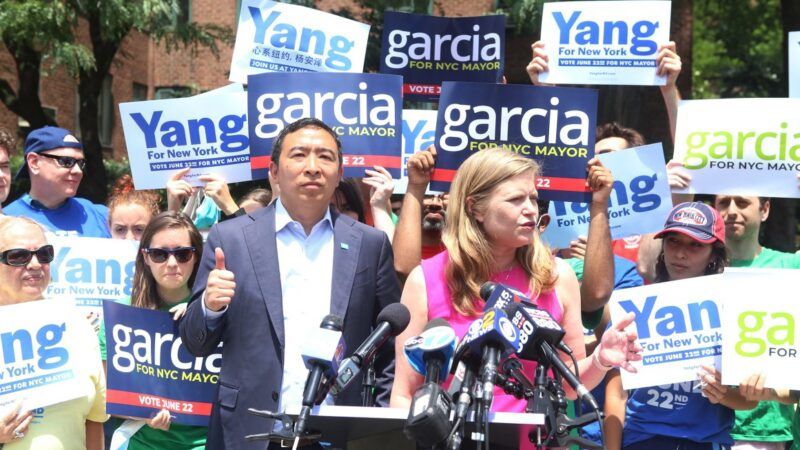Ranked Choice Voting Gets Biggest Test Yet in New York City
Democrats have 13 choices in the mayoral primary. They get to rank their top five.

New York City's raucous mayoral primary today will be the country's most prominent test of ranked choice voting. How it all works out may make the case for wider adoption.
Democratic Party voters have 13 mayoral candidates on their ballots. They don't have to select just one to face off against Republican and third-party candidates in the November general election; they can choose and rank up to five candidates in order of preference.
With ranked choice voting, it's not enough for the top candidate to get a plurality of the votes. He or she must have a majority in order to be declared a winner. When the votes are first tallied, if no candidate has crossed the 50 percent threshold, a winner is not declared. Instead, the candidate with the least number of votes is eliminated. Then the votes are tallied again. For each voter who ranked the eliminated candidate as their top choice, their second choice is now counted as their vote. If that's still not enough for a single candidate to pass 50 percent, the elimination and retabulation continues. When one candidate is able to lay claim to at least 50 percent of the votes, that candidate is named the winner.
With 13 candidates splitting up all the votes, this can get super complicated, and it may be weeks before the actual winner is determined. As it is, the city's Board of Elections will not begin tabulating the ranked choices until next week, so unless one candidate gets 50 percent of the vote tonight (which seems extremely unlikely), New Yorkers are in for a wait.
The politics of these elections change a bit when ranked choice voting is used, encouraging alliances between candidates in the hopes that voters will rank them first and second, increasing both of their chances of winning as other candidates are eliminated. This happened in San Francisco, which also has ranked choice voting for mayoral elections, when two candidates teamed up in 2018 in the hopes that one of them would overtake London Breed. They were unsuccessful and Breed ended up winning anyway.
In New York City, candidates Andrew Yang and Kathryn Garcia have been campaigning together in the hopes voters will rank them together and push current front-runner Eric Adams down the ballots. As Reason's Matt Welch noted yesterday, this provoked a rather strange response from Adams that their politicking is a form of "voter suppression," the idea being that ranked choice voting is somehow a mechanism for deemphasizing the power of black voters.
That's an absurd—almost backward—reading of what happens when ranked choice voting is used. The end result in San Francisco was that a black woman became mayor! Fellow candidate Maya Wiley blasted Adams' argument in a statement, saying that "using racism charges to undermine confidence in ranked choice voting is cynical, self-interested, and dangerous." She continued:
Ranked Choice Voting protects the voice of Black and brown voters. Studies have shown that Ranked Choice Voting has a positive impact on candidates or voters of color. Here in New York City, Ranked Choice Voting will prevent a run-off election, which would see significant drop off, especially in communities of color.
Ranked Choice Voting—or alliances formed from it—is not voter suppression, it's not a poll tax and to compare it to that denigrates the work of so many who have come before us.
In May, FairVote, a nonprofit organization that promotes ranked choice voting, produced a study showing that minority candidates actually benefit from the system, and found that black and Latino candidates found their vote totals growing between tabulation rounds at a higher rate than white candidates. When voters aren't forced to choose just one candidate, they're more likely to cross racial and ethnic lines when ranking candidates.
Ranked choice voting also benefits candidates from third parties because voters don't have to "throw their vote away" to select a Libertarian or Green Party candidate.
That's not important for this primary, but it does also allow for a diversity of candidate positions within a single dominant party. It's extremely likely that whoever wins the Democratic primary in New York City is going to be the next mayor. Ranked choice voting allows the city's Democrats to better shape what kind of Democrat is going to lead.


Show Comments (26)